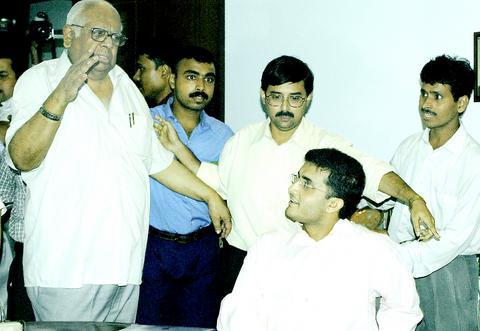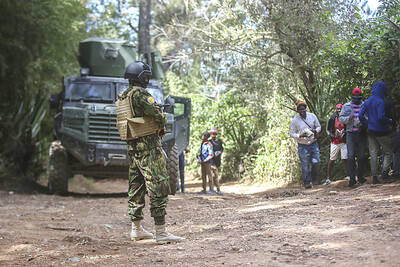Manmohan Singh, the Oxford-educated economist who crafted India's economic liberalization policies, was sworn in as prime minister yesterday, placing the Congress party back in control of the nation after eight years on the sidelines.
Singh, India's first prime minister to come from the country's influential Sikh minority, was sworn in by President A.P.J. Abdul Kalam, who is himself from India's large Muslim minority.

PHOTO: AFP
The Congress party, whose leader, Italian-born Sonia Gandhi, declined the top post last week, will lead a minority coalition after it ousted former prime minister Atal Bihari Vajpayee's Hindu-nationalist government in a tumultuous round of elections held over two months in April and May.
After several days of bargaining with coalition partners over key ministerial posts, the 71-year-old technocrat took the oath of office, dressed in a light blue Sikh turban and white, high-neck cotton tunic.
An estimated 68 other key allies were also being sworn in as Union Ministers by Kalam -- including Bollywood actor Sunil Dutt -- in a ceremony at his imposing, pink sandstone palace in the heart of New Delhi.
A Congress party official told reporters on condition of anonymity that the final list of Cabinet posts would not be made official until today. It has been widely reported that Singh himself would take on a dual role as both prime minister and finance minister, a position he held in the early 1990s under a previous Congress-led government.
Singh and Congress party president Sonia Gandhi have been meeting with leaders of different political parties to haggle over the number of spots each party would receive in the Cabinet.
Singh is expected to assign key ministries such as foreign affairs, defense and security to members of his own party, but leave several high-profile economic ministries like petroleum, communications and rural development for allies, the official said.
The partners were pleased with the results of the negotiations, which ended early yesterday, the official said.
On Friday, the leaders of the Congress-led group -- named the United Progressive Alliance, or UPA -- finished drafting an outline of the new government's political and economic priorities.
"The UPA government will give the highest priority to building closer political, economic and other ties with its neighbors in South Asia," said the draft, a copy of which was made available yesterday.
Efforts launched by the previous government to resolve India's decades-old dispute with Pakistan over the Himalayan region of Kashmir -- the cause of two wars between the nuclear rivals -- will be "pursued systematically and on a sustained basis," it said.

DITCH TACTICS: Kenyan officers were on their way to rescue Haitian police stuck in a ditch suspected to have been deliberately dug by Haitian gang members A Kenyan policeman deployed in Haiti has gone missing after violent gangs attacked a group of officers on a rescue mission, a UN-backed multinational security mission said in a statement yesterday. The Kenyan officers on Tuesday were on their way to rescue Haitian police stuck in a ditch “suspected to have been deliberately dug by gangs,” the statement said, adding that “specialized teams have been deployed” to search for the missing officer. Local media outlets in Haiti reported that the officer had been killed and videos of a lifeless man clothed in Kenyan uniform were shared on social media. Gang violence has left

US Vice President J.D. Vance on Friday accused Denmark of not having done enough to protect Greenland, when he visited the strategically placed and resource-rich Danish territory coveted by US President Donald Trump. Vance made his comment during a trip to the Pituffik Space Base in northwestern Greenland, a visit viewed by Copenhagen and Nuuk as a provocation. “Our message to Denmark is very simple: You have not done a good job by the people of Greenland,” Vance told a news conference. “You have under-invested in the people of Greenland, and you have under-invested in the security architecture of this

Japan unveiled a plan on Thursday to evacuate around 120,000 residents and tourists from its southern islets near Taiwan within six days in the event of an “emergency”. The plan was put together as “the security situation surrounding our nation grows severe” and with an “emergency” in mind, the government’s crisis management office said. Exactly what that emergency might be was left unspecified in the plan but it envisages the evacuation of around 120,000 people in five Japanese islets close to Taiwan. China claims Taiwan as part of its territory and has stepped up military pressure in recent years, including

UNREST: The authorities in Turkey arrested 13 Turkish journalists in five days, deported a BBC correspondent and on Thursday arrested a reporter from Sweden Waving flags and chanting slogans, many hundreds of thousands of anti-government demonstrators on Saturday rallied in Istanbul, Turkey, in defence of democracy after the arrest of Istanbul Mayor Ekrem Imamoglu which sparked Turkey’s worst street unrest in more than a decade. Under a cloudless blue sky, vast crowds gathered in Maltepe on the Asian side of Turkey’s biggest city on the eve of the Eid al-Fitr celebration which started yesterday, marking the end of Ramadan. Ozgur Ozel, chairman of the main opposition Republican People’s Party (CHP), which organized the rally, said there were 2.2 million people in the crowd, but